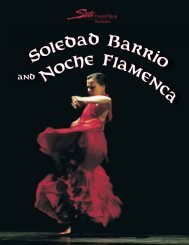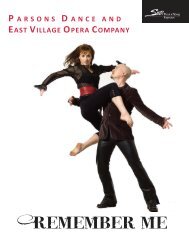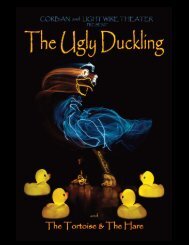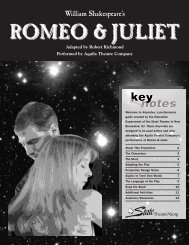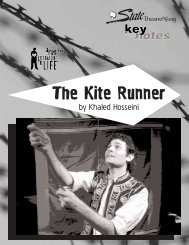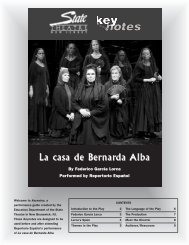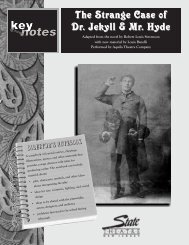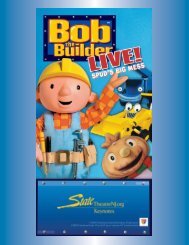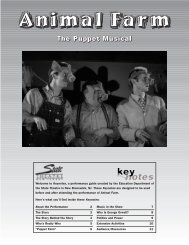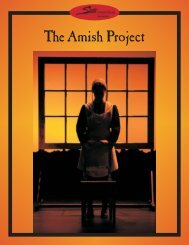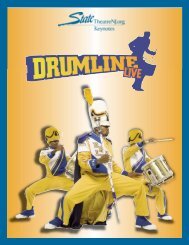Grug Keynotes:Layout 1.qxd - State Theatre
Grug Keynotes:Layout 1.qxd - State Theatre
Grug Keynotes:Layout 1.qxd - State Theatre
You also want an ePaper? Increase the reach of your titles
YUMPU automatically turns print PDFs into web optimized ePapers that Google loves.
LIVE!
Welcome!2<strong>State</strong> <strong>Theatre</strong> in New Brunswick, New Jersey welcomes you tothe school-day performance of <strong>Grug</strong>. Australia’s Windmill<strong>Theatre</strong> has created a delightful production designed to offervery young children the perfect introduction to live theater.These <strong>Keynotes</strong> provide information and activities to helpyou prepare your students for the performance and lead themin follow-up activities. We encourage you to share yourfeedback on the show, as well as any activities or lesson plansyou created in connection with the performance. You can reachus at:Director SamHaren with<strong>Grug</strong> and CaraEducation@<strong>State</strong><strong>Theatre</strong>NJ.orgContentsWelcome ..........................................................................................................2Meet <strong>Grug</strong> ......................................................................................................3About the Show ............................................................................................4The Land “Down Under”............................................................................5Puppet Power!................................................................................................6<strong>Grug</strong> Template ..............................................................................................7More To Do ....................................................................................................8Resources ........................................................................................................9What’s My Job? ..........................................................................................10<strong>Keynotes</strong> are produced by the Education Department of the <strong>State</strong><strong>Theatre</strong>, New Brunswick, NJ.Mark W. Jones, President & CEOLian Farrer, Vice President for EducationOnline at www.<strong>State</strong><strong>Theatre</strong>NJ.org/<strong>Keynotes</strong><strong>Keynotes</strong> for <strong>Grug</strong> created by Lian Farrer and Jennifer Cunha.© 2013 <strong>State</strong> <strong>Theatre</strong><strong>Grug</strong> production photos: Tony LewisFind us at www.<strong>State</strong><strong>Theatre</strong>NJ.orgContact: education@<strong>State</strong><strong>Theatre</strong>NJ.org<strong>State</strong> <strong>Theatre</strong>, a premier nonprofit venue for the performing artsand entertainment.The <strong>State</strong> <strong>Theatre</strong>’s education program is funded in part by Colgate-Palmolive, Cream-O-Land Dairy, E & G Foundation, Great-West Life &Annuity Insurance Company, The Horizon Foundation for New Jersey,Ingredion, Johnson & Johnson Family of Companies, J. Seward Johnson, Sr.1963 Charitable Trust, Karma Foundation, The Blanche and Irving LaurieFoundation, McCrane Foundation, MetLife Foundation, New Jersey <strong>State</strong>Council on the Arts, The Provident Bank Foundation, PSE&G, and RobertWood Johnson Foundation. Their support is gratefully acknowledgedFunding has been madepossible in part by the NewJersey <strong>State</strong> Council on theArts/Department of <strong>State</strong>, apartner agency of the NationalEndowment for the Arts.The Heldrich is theofficial hotel of the<strong>State</strong> <strong>Theatre</strong>.
Meet <strong>Grug</strong>!3Once the top of a Burrawang treefell to the ground...and the grassy top began to change.It became <strong>Grug</strong>.<strong>Grug</strong> is the title character in a series ofpicture books by Australian author TimPrior. Published between 1979 and 1992,the <strong>Grug</strong> series comprises more than twodozen books, each relating a differentadventure as <strong>Grug</strong> faces everydaysituations—learning patience andproblem-solving skills as he experiencesthe world around him.Tim PriorMore than 30 years ago, Tim Prior wasliving on a small farm in northern New South Wales. He hadjust started reading stories to his two very young children andthought he would try to create his own imaginary bush animaland write a story about it. He doodled around and came upwith <strong>Grug</strong>. The character reflects Prior’s love of nature andsimplicity, and also his core personal values, which he lists astruthfulness, compassion, and integrity.In the very first <strong>Grug</strong> book, <strong>Grug</strong> begins his life as the top ofa burrawang tree that falls to the ground. Slowly, he begins tochange. Hedevelops stripesand grows a nose,eyes, and mouth,becoming theadorable, inquisitive creature beloved by thousands ofAustralian children, as well as young people the world over.What’s a Burrawang Tree?The burrawang tree is found along the coast of NewSouth Wales in Australia. Its name comes from the DarukAustralian Aboriginal language. A burrawang tree looks alot like a palm tree, but it’s really a cycad—a type of plantthat existed even before dinosaurs roamed the earth!During the Jurassic Period, cycads were common in manyparts of the world— so common, in fact, that the Jurassicis often referred to as the "Age of Cycads." Though theywere once a common sight around the world, cycads arenow faced with extinction in the wild.Today’s cycads are stillremarkably similar totheir distant ancestors.They have stout trunkstopped by a crown ofvery large, stiff evergreenleaves. The seeds arevery large, and oftenbrightly colored—red,purple, or yellow— Here’s a picture of a realburrawang tree. Have studentsattracting birds andcompare it to the illustrationmammals that help from the book. Do they think itspread the seeds.looks like the illustration?
About the Show4This stage adaptation of <strong>Grug</strong>, by Australia’sWindmill <strong>Theatre</strong>, combines elements of a numberof the stories. In the show, <strong>Grug</strong> receives a series ofparcels (packages). Each one contains a gift thatsets him off on a new adventure. He will buildhimself a house, plant a garden, go fishing, find agiant red apple, play soccer, invent a new dance,and throw himself a birthday party.Throughout the play, <strong>Grug</strong> approaches everysituation calmly, gently, and patiently. When hegrows a garden and discovers a snail eating hiscabbages, he doesn’t get upset; instead, he plantsenough for both himself and the snail. When he istrying to learn how to dance and the moves provetoo difficult, he creates his own dance called “The<strong>Grug</strong>.” Together with his friend Cara the carpetsnake, <strong>Grug</strong> solves problems as he encounters newsituations, learning about the world around him.The performers bring <strong>Grug</strong> and Cara to lifeusing storybook-style narration and severaldifferent types of puppetry. (<strong>Grug</strong> himself doesn’tspeak.) The ingeniously-designed set looks like asimple hillside, but holds many wonders andsurprises to enchant and delight young audiences.Production CreditsDirector: ......................................................................Sam HarenDesigner: ........................................................Jonathon OxladeComposer: ........................................................................DJ TR!PPuppet Maker/Consultant ..............................Tamara RewsePerformers: ..............................................................Ellen SteeleHamish FletcherMatt CrookWhat Would You Do?<strong>Grug</strong> often encounters situations that might make other peopleupset. Have a discussion with your students about what they would doin the following situations.• You find out that a snail has been eating the cabbage you plantedfor yourself.• You spend all day fishing, but don’t catch anything.• You get a brand new soccer ball, but don’t know where to play.As a class, come up with another situation. It might be one thatyou’ve actually experienced, for example: there is only one toy butseveral children want to play with it. How do you think <strong>Grug</strong> wouldreact in this situation? Would he get angry and upset or would he finda way to work through it?Set designer’smodel for <strong>Grug</strong>.
The Land “Down Under”5Like <strong>Grug</strong>, Windmill <strong>Theatre</strong> are natives of Australia. Sharesome information about Australia with your students.Australia Facts• Australia is located in the Earth’s southernhemisphere, which is why it’s known as the land“Down Under.”• Australians sometimes refer to their country as“Oz,” and to themselves as “Aussies” (OZ-zies).• Australia’s seasons are the exact opposite ofours; when it’s summer here, it’s winter there—and vice versa.• The capital of Australia is Canberra. The countryhas six states and two major territories.• Australia is the sixth-largest nation in area and isthe only country that covers an entire continent.• The indigenous peoples of Australia are called“Aborigines” (ab-uh-RIDG-in-eez). They havelived there for over 50,000 years.WesternAustraliaPerthNorthernTerritorySouthAustraliaAdelaideWindmill<strong>Theatre</strong>QueenslandNew SouthWalesVictoriaBrisbaneMelbourneTasmaniaSydneyCanberra• About 40% of Australia is desert. Australia hasmore beaches than any other country in theworld.• Windmill <strong>Theatre</strong> is based in Adelaide, thecapital of the state of South Australia. SouthAustralia is where you’ll see the most burrawangtrees!Australia’sAborigines inventedthe boomerang, a curvedpiece of wood that comesback to you when youthrow it.HobartMeet the Real Cara!Australia is famous for two animals: the kangarooand the koala. Can your students identify them?Another of Australia’s nativeanimals is the carpet snake,which is the inspiration for Cara in<strong>Grug</strong>. A type of python, it is notpoisonous; it kills its prey by wrapping its bodyaround it and squeezing it tightly. Carpet snakes are typically notas big as other python species, but still can grow as long as 9 feet.The most common color is olive green, with pale, dark-edgedblotches, stripes, or cross-bands.
Puppet Power!6Puppetry is a prominent feature of Windmill <strong>Theatre</strong>’sproduction of <strong>Grug</strong>. Here are two art projects you can useto have your students make their own puppets for <strong>Grug</strong>and Cara, the two main characters in the performance.When the puppets are finished, have children experimentwith using them: creating voices, movements, and apersonality. Encourage them to create a story for their<strong>Grug</strong>.Have students show and describe their <strong>Grug</strong>s to therest of the class and tell them about their adventure. Leada discussion about what was different and what was similarabout all the <strong>Grug</strong>s.Make Your Own <strong>Grug</strong>You Will Need:• <strong>Grug</strong> template on the next page• heavy paper• glue and/or tape• crayons, markers, colored pencils, etc.• yarn, string, glitter, felt, pipe cleaners, and other craftsupplies for decorating puppetsDirections:1. On heavy paper, copy the template on the next page:one for each child.Make Your Own CaraYou Will Need:• scarves, socks, or otherlong, thin pieces of fabric• craft sticks, woodenchopsticks, pencils, orsome other type ofsturdy stick.• glue• google eyes• yarn, felt, construction paper, pompons, ,and other craftsupplies for decorating puppetsDirections:1. Help students attach each end of the fabric or sock withglue. (Hot glue works well, but if you decide to use it, you’llneed to do this step yourself.)2. Have them glue a pair of googly eyes to one end of thepuppet and decorate the body with the yarn, string, etc.3. Ask students to describe how a snake moves. Guide them inmoving the two sticks of their Cara puppet to imitate themovement of a snake.2. Ask children to color <strong>Grug</strong>. Don’t forget to have themadd a large nose, eyes, and mouth. Have them decoratetheir <strong>Grug</strong> with the yarn, string, glitter, etc. to make their<strong>Grug</strong> unique.3. Have them cut out their <strong>Grug</strong> along the outline.You may need to help them with this step.4. Have them glue a few strands of yarn onthe top of <strong>Grug</strong>’s head.5. Cut out the strip on the same page asthe template. Fold along the dotted linesand glue or tape down the sections withthe word “Glue” so that the center is pokingout as a handle.
<strong>Grug</strong> Template7GlueGlue
More to Do8<strong>Grug</strong> is rich in ideas and concepts that will make great topics for explorationand discussion with students. Here are some suggested activities.DrawGo FishingDuring the show, you will see <strong>Grug</strong> gofishing. Lay out some towels and putdown a small pool or bucket filledwith water. In the water, place anassortment of magnets that you don’tmind getting wet. Create a fishingpole by tying a piece of string ortwine to a yardstick. At the end of thestring, attach a small magnet andhave your students go fishing. Ifyou’re using magnets that aren’t fishor other ocean life, have the studentscome up with a story of how themagnet they caught came to be inthe water. For instance, if they caughta tomato magnet, how did thetomato get in the pond?When <strong>Grug</strong> first comes to life, he has to decide where to live.Does he want to live where it’s snowy, where there’s a forest, orsomewhere else? He eventually decides to live in a burrow.Have each student pick a different place for <strong>Grug</strong> to live anddraw him and his home there.Write<strong>Grug</strong> has a letter box outside of his home. Haveyour students write a letter to <strong>Grug</strong>, eitherindividually or as a class, and mail it to him atthe <strong>State</strong> <strong>Theatre</strong>!Plant a GardenNow that it’s almost spring, it’s theperfect time to plant a garden. When<strong>Grug</strong> plants a garden, he plantsvegetables to eat, grass for his bed,and flowers for their beauty. Decidewhat your class wants to plant andwhy. If you have space outside, youcan plant your garden outside, but ifnot, you can use flower pots andmake your garden right in yourclassroom. If you have classroomchores, you can add “<strong>Grug</strong>” to the listand have students water the plant.Celebrate!<strong>Grug</strong> doesn’t know when his birthday is, so hedecides to throw himself a birthdayparty. Once your class makes their<strong>Grug</strong> puppets, throw a birthday partyfor him! How old do you think <strong>Grug</strong> is?
Resources9Books<strong>Grug</strong>. Simon & Schuster, 2009. The original story.You can use the following books to complement theperformance and expand on some of the themes presentedin the show.<strong>Grug</strong> and the Big Red Apple:The Apple Pie Tree, by Zoe Hall, illustrated by Shari Halpern.Blue Sky Press, 1996. Grades pre-k-1.Two sisters observe the changes in their backyard apple treethroughout the seasons. In autumn, they pick the applesand bake them in a pie. Includes an apple pie recipe!<strong>Grug</strong> Goes Fishing:Curious George Goes Fishing, by Margaret Rey, illustrated byH.A. Rey. HMH Books, 2001. Grades K-2.Jangles: A Big Fish Story, by David Shannon. Blue Sky Press,2012. Grades pre-K-3.A young boy is befriended by a giant trout, who takes himon an adventure to the bottom of the lake.<strong>Grug</strong> Grows a Garden:How to Grow a School Garden: A Complete Guide for Parentsand Teachers, by Arden Bucklin-Sporer and Rachel Pringle.Timber Press, 2010.Jack's Garden, written and illustrated by Henry Cole.Greenwillow Books, 1997. Grades pre-K-2.This picture book traces a little boy's backyard flowergarden from tilling the soil to enjoying the blossoms.<strong>Grug</strong> Learns to Dance:The Animal Boogie (A Barefoot Singalong), written andillustrated by Debbie Harter. Barefoot Books, 2011. Gradespre-k-2.Down in the jungle, than animals get together to dance,each finding its own style of moving and grooving. Therhythm of the text encourages children to boogie-woogieright along.<strong>Grug</strong> Has a Birthday:Happy Birthday to You!, by Dr. Seuss. Random House Booksfor Young Readers, 1959.<strong>Grug</strong> Plays Soccer:Soccer Sam (Step into Reading, Step 4), written by JeanMarzollo, illustrated by Blanche Sims. Random House Booksfor Young Readers, 1987. Grades 2-3.Sam's cousin from Mexico teaches Sam's second-gradeclassmates how to play soccer. The book introduces someSpanish words and phrases.These books will help you explore Australia with yourstudents.D is for Down Under: An Australia Alphabet (Discover theWorld), by Devin Scillian, illustrated by Geoff Cook. SleepingBear Press, 2010. Grades 1-4.Accompanied by rich illustrations, this alphabet book is anA-Z exploration of Australia, from natural wonders andlandmarks to people, foods, and industries.Over in Australia: Amazing Animals Down Under, by MarianneBerkes, illustrated by Jill Dubin. Dawn Publications, 2011.Grades pre-K-2.This picture book introduces ten animals native to Australia,setting each description to the tune “Over in the Meadow.”Onlinewww.mygrug.comThe official website of <strong>Grug</strong>. Full of information, funactivities, and coloring pages. You can even listen to the<strong>Grug</strong> song and first story on the home page!authors.simonandschuster.com.au/Ted-PriorTed Prior’s website with a complete list of books.www.windmill.org.au/show/grugWindmill <strong>Theatre</strong> Company’s website with more informationabout the show.
What’s My Job?10Going to see a play at a theater is not the same as watching TV. When you are sitting in audience at the<strong>State</strong> <strong>Theatre</strong>, the actors will be in the same room as you. They will be able to hear and see everythingthat goes on in the audience. Use the key to find out what your job is at the performance.look listen performance audience clapWhen I go to a , I am part of the . This is a veryimportant job. I have to and carefully.If I talk or move around, the actors and thewill have ahard time paying attention to the .When the is over, it’s okay for me to .



